Great news! Sheep to Shawl is coming to Reno!
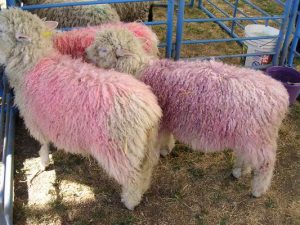
Kool-aid sheep
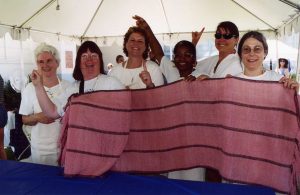
Lambtown team
There’s nothing like a competition to test your skills. That goes for spinning and weaving too. Sheep-to-Shawl events provide spinners and weavers the opportunity to strut their stuff, hone their skills with all the excitement of a sporting event.
You will find Sheep to Shawl events throughout the country at county fairs, state fairs, and sheep and wool festivals. This process of taking wool from the sheep to a finished garment has been fascinating people for generations. Ever since 1811, when Sir John Throckmorton of Newbury, England wagered that he could have a wool jacket made from his own sheep in one day – and won!
Competition adds a boost of excitement with the urgency and suspense of ‘race to the finish’ not usually associated with spinning/weaving activities. Like every sports team these Sheep to Shawl teams are going for a WIN!
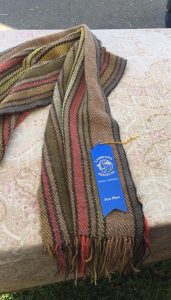
A winning shawl
The Sheep-to-Shawl coming to 2018 Convergence this year presents a great opportunity to try it out and see what you can do. The Rules and conditions are designed to enable teams to produce good quality shawls in the allotted time, so take advantage of this ideal opportunity whether you are beginning or experienced. You will learn a lot and have a good time.
If you are itching to get into the race, and I hope you are – Register at http://www.weavespindye.org/sheep-to-shawl-competition ASAP to reserve your space.
When you are ready to go for it, start by reading the Rules and the Score Sheet.
See Sheep to Shawl Competition Rules at www. CNCH 2018
The Rules for Reno define the team members(8), shawl dimensions (1400 sq. ins), warp and weft requirements etc …read the Rules for details.
The Score Sheet will tell you what the judge will be looking for in awarding points. Since earning points is the way to a win, check it out. There are 100 points at stake, 20 of them on signage, display, information items that can be made before the event.
About the competition
The challenge is for the team to weave a shawl within 4 hours. Starting with a warped loom and unprepared fleece.the team will:
• prepare the fleece by opening up the locks, teasing and carding,
• spin the prepared fleece either as singles or plyed yarn,
• weave to required length,
• cut the shawl from the loom,
• make finishing details,
• present the shawl to the judge for scoring. Four hours!
The team with the most points wins. YAY!
How to Win –Hopefully Helpful Hints from Silverado Spinsters
There are a few things to do before being ready to take the stage:
Recruit a Team.
Look for enthusiastic spinners with a killer instinct; a calm, steady unflappable, weaver with a steady beat, and impeccable selvedges; and a cheerful outgoing educator with encyclopedic knowledge of fiber work who will defend the team against interference from spectators.
Super fiber prep, spinner-power and weaver calm and accuracy, will determine how well a shawl can be spun, woven and finished in the allotted time.
Read the Rules
Make sure you understand all the rules and ask questions if you aren’t clear. The rules define the composition of the team and describe any limitation on tools and equipment and answer most other questions. Can you use a drum carder? – yes one manual drum carder. Electric carders? – no, or spinners? – one battery operated. Do you supply your own fleece or is it provided? – bring your own. Is the shawl measured on the loom or off? – off loom. Square inches or set width and length? – 1440 sq. ins ……and more. You really must read the rules!
Design the Shawl
Decide on the character of the shawl to guide your selections on warp, weave structure, colors, and fiber choice. Warm and wooly, or elegant and with drape, be sure to describe your intentions in your Weaving Notes also check the Score Sheet for what the judge will be looking for in awarding points.
Choose a warp that will stand up to the rigors of warping, weaving and being hauled around on the loom. Handspun is preferred. It allows up to 10 points more and integrates with your weft, but, commercial yarn is permitted and may be more dependable if you are unsure of the strength and consistency of your handspun supply.
For the weft be very picky on the selection of the fleece. It will determine ease of preparation, the speed and smoothness of the spinning and ultimately contribute to the quality of the finished shawl. Note: fine fleece with a tight crimp will tend to take-up a lot when off the loom . i.e. may take up and ‘shrink’ loosing length or width. If be dyeing it, check that the fleece can handle the process without felting. Avoid dark colors like black – harder to see when spinning to produce an even yarn.
For the Weave structure the Rules dictate a 4-shaft draft. Use a pattern with a short repetitive treadling order to allow the weaver to develop a rhythm thus reducing the chance of treadling errors. Avoid drafts with long floats. They may look loose when off-the-loom without wet-
finishing. Twill works well in shawls and is more forgiving of spinning flaws than plain weave where irregularities are more obvious.
The overall look and feel of the shawl and the use of color are subjective qualities that can impress the judge to give you an edge. Your judge will be a factor here.
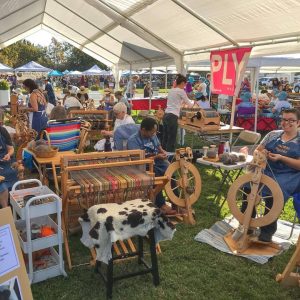
The overall scene
Preparation work
Spinners will want to choose the weft fiber, spin samples and adopt a standard for twist and grist (or sense what it wants to do), then check that they are all spinning the same uniform yarn. Spinning together before the competition helps work out details and get into a good rhythm. Match singles when plying to get a more consistent yarn. Count your treadles.
The Weaver will be involved with making the warp the loom. Make it at least as long as the shawl plus an extra yard or two for samples, take-up and loom waste. . – Don’t wait until the last minute for warping, do it early so you have time to work out problems.
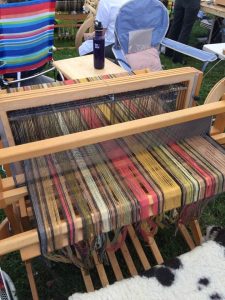
The warped loom
Weave a sample(s) – check for threading errors, establish the beat, and the smooth operation of the loom. It will be needed for the weaver’s notes and team display. Watch your weaver’s beat. In competitions it can be easy to beat too hard and pack in the weft. Examine the cloth for hand and drape and make adjustments as needed.
Design the finishing details – determine the time they will take. . Are you planning to knot or twist your fringe? Practice and assign roles. Have a plan B in case you run short of time.
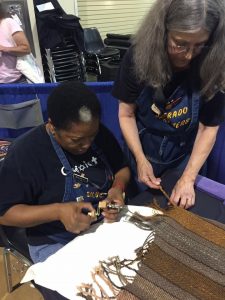
Finishing
Other Requirements
While the spinning and weaving part of preparations are the most exciting don’t forget the other requirements that comprise 25% of the points. Have someone keep track of the following:
An informational display including a poster with information on the shawl design and sample of you warp and weft materials. Small woven samples for handling are popular. Its the chance to showcase your team.
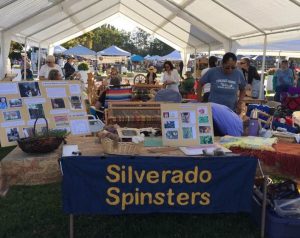
Group display
Decide on the team’s ID requirement – “costumes are encouraged” pioneer garb, or something wild and wooly, other options here may be hats, aprons, sashes, T-shirts, reflecting the team’s character.
Weavers Notes. These are notes to accompany the finished shawl to the judge. Information on the shawl including weaving draft, fiber content with sample of warp, sample of weft fiber and weft spun during the competition and yarn and dye samples if used. An opportunity to impress the judge!
Gear up
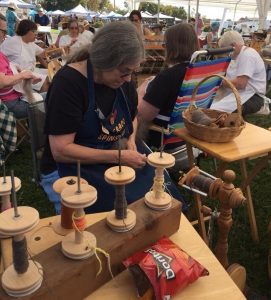
Have your equipment in good order
Fine tune your equipment, wheels, loom. Check that all spinners’ bobbins fit the plyer’s kate.
Bring repair kits for loom, warp and wheels and a tool box for any eventuality.
Head to the game as a well prepared cheerful, competent team, able to stay calm and productive amid the excitement and many distractions. Then strut your stuff!
Go for the big WIN!
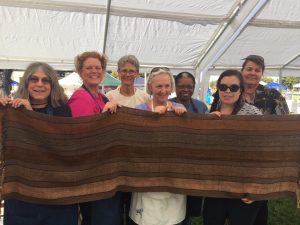
The group won!
….. but consider it a success if you have delivered a finished shawl to the judge within the time period, and whatever your score you will have improved your.fiber skills, enjoyed being a part of a team sharing a room wth 50 spinning wheels and 10 looms – that’s awesome!
Gather a few fiber friends and get started forming your killer team.now.
If you don’t manage to field a team drop by to see the excitement at the Vendor Hall on Saturday 12 – 4
About Silverado Spinsters;
The first appearance of Silverado Spinsters* was in the CNCH2003 1st National Fiber to Shawl Competition held at the Nevada.County fairgrounds.
Ten teams competed. It was a thrilling affair……and the Silverado Spinsters won. The goal of the team had been to make a lightweight shawl with good hand and drape. The team has continues to focus on spinning finer yarns, and weaving lighter shawls. They win often, with an occasional spectacular failure.
*The name recognized that the team includes members of Silverado Weavers Guild in Napa and the Twisted Spinsters a group in Solano County.